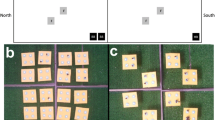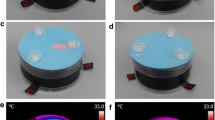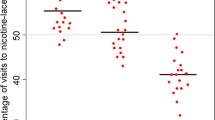Abstract
Several authors have found that flowers that are warmer than their surrounding environment have an advantage in attracting pollinators. Bumblebees will forage preferentially on warmer flowers, even if equal nutritional reward is available in cooler flowers. This raises the question of whether warmth and sucrose concentration are processed independently by bees, or whether sweetness detectors respond to higher sugar concentration as well as higher temperature. We find that bumblebees can use lower temperature as a cue to higher sucrose reward, showing that bees appear to process the two parameters strictly independently. Moreover, we demonstrate that sucrose concentration takes precedence over warmth, so that when there is a difference in sucrose concentration, bees will typically choose the sweeter feeder, even if the less sweet feeder is several degrees warmer.



Similar content being viewed by others
References
Bartoshuk LM, Rennert K, Rodin J, Stevens JC (1982) Effects of temperature on the perceived sweetness of sucrose. Physiol Behav 28:905–910
Bishop JA, Armbruster WS (1999) Thermoregulatory abilities of Alaskan bees: effects of size, phylogeny and ecology. Funct Ecol 13:711–724
Blüthgen N, Fiedler K (2004) Preferences for sugars and amino acids and their conditionality in a diverse nectar-feeding ant community. J Anim Ecol 73:155–166
Chittka L, Geiger K (1995) Honeybee long-distance orientation in a controlled environment. Ethology 99:117–126
Chittka L, Dyer AG, Bock F, Dornhaus A (2003) Bees trade off foraging speed for accuracy. Nature 424:388
Comba L, Corbet SA, Hunt H, Outram S, Parker JS, Glover BJ (2000) The role of genes influencing the corolla in pollination of Antirrhinum majus. Plant Cell Environ 23:639–647
Corbet SA (1978) Bee visits and the nectar of Echium vulgare L. and Sinapis alba L.. Ecol Entomol 3:25–27
Dyer AG, Chittka L (2004) Biological significance of discriminating between similar colours in spectrally variable illumination: bumblebees as a study case. J Comp Physiol A 190:105–114
Dyer AG, Neumeyer C (2005) Simultaneous and successive colour discrimination in the honeybee (Apis mellifera). J Comp Physiol A 191:547–557
Dyer AG, Whitney HM, Arnold SEJ, Glover BJ, Chittka L (2006) Bees associate warmth with floral colour. Nature 442:525
Génotelle J (1978) Expression de la viscosité des solutions sucrées. Ind Aliment Agric 95:747–755
Grandi G (1961) The hymenopterous insects of the superfamily Chalcidoidea developing within the receptacles of figs. Boll Ist Entomol Univ Studi Bologna 26:1–3
Harder LD (1986) Effects of nectar concentration and flower depth on flower handling efficiency of bumble bees. Oecologia 69:309–315
Heinrich B, Esch H (1994) Thermoregulation in bees. Am Sci 82:164–170
Heran H (1952) Untersuchungen über den Temperatursinn der Honigbiene (Apis mellifica) unter besonderer Berücksichtigung der Wahrnehmung strahlender Wärme. Z Vgl Physiol 34:179–206
Herrera CM (1995) Floral biology, microclimate, and pollination by ectothermic bees in an early-blooming herb. Ecology 76:218–228
Kevan PG (1975) Sun-tracking solar furnaces in high Arctic flowers: significance for pollination and insects. Science 189:723–726
Kevan PG (1976) Fluorescent nectar. Science 194:341–342
Kevan PG (1989) Thermoregulation in arctic insects and flowers: Adaptation and co-adaptation in behaviour, anatomy, and physiology. In: Mercer, J (eds) Thermal physiology. Elsevier (Biomedical Division), Amsterdam, pp 747–753
Lacher V (1964) Elektrophysiologische Untersuchungen an einzelnen Rezeptoren für Geruch, Kohlendioxyd, Luftfeuchtigkeit und Temperatur auf den Antennen der Arbeitsbiene und der Drohne (Apis mellifica L.). Z Vgl Physiol 48:587–623
Menzel R, Chittka L, Eichmüller S, Geiger K, Peitsch D, Knoll P (1990) Dominance of celestial cues over landmarks disproves map-like orientation in honey bees. Z Naturforsch 45c:723–726
Mojet J, Köster EP, Prinz JF (2005) Do tastants have a smell. Chem Senses 30:9–21
Nieh JC, Leon A, Cameron S, Vandame R (2006) Hot bumble bees at good food: thoracic temperature of feeding Bombus wilmattae foragers is tuned to sugar concentration. J Exp Biol 209:4185–4192
Pye D (in press) To add another hue unto the rainbow—near ultraviolet in nature. Optics and Laser Technology
Rands SA, Whitney HM (2008). Floral temperature and optimal foraging: is heat a feasible floral reward for pollinators? PLoS ONE 3(4):e2007. DOI 10.1371/journal.pone.0002007
Saleh N, Scott AG, Bryning GP, Chittka L (2007) Distinguishing signals and cues: bumblebees use general footprints to generate adaptive behaviour at flowers and nest. Arthropod-Plant Interact 1:119–127
Sapir Y, Shmida A, Ne΄eman G (2006) Morning floral heat as a reward to the pollinators of the Oncocyclus irises. Oecologia 147:53–59
Schmidt VM, Schorkopf DLP, Hrncir M, Zucchi R, Barth FG (2006) Collective foraging in a stingless bee: dependence on food profitability and sequence of discovery. Anim Behav 72:1309–1317
Seeley TD (1995) The wisdom of the hive. Harvard University Press, Cambridge
Seymour RS, White CR, Gibernau M (2003) Heat reward for insect pollinators. Nature 426:243–244
Stromberg MR, Johnsen PB (1990) Hummingbird sweetness preferences: taste or viscosity. Condor 92:606–612
Talavera K, Yasumatsu K, Voets T, Droogmans G, Shigemura N, Ninomiya Y, Margolskee RF, Nilius B (2005) Heat activation of TRPM5 underlies thermal sensitivity of sweet taste. Nature 438:1022–1025
von Frisch K (1967) The dance language and orientation of bees. Harvard University Press, Cambridge
Acknowledgements
We thank Tom Collett and Simon Laughlin for discussions and Lucy Sandbach and David Prince for help with data collection. The project is funded by NERC grant NE/C000552/1. AGD is supported by ARC DP0878968.
Author information
Authors and Affiliations
Corresponding author
Rights and permissions
About this article
Cite this article
Whitney, H.M., Dyer, A., Chittka, L. et al. The interaction of temperature and sucrose concentration on foraging preferences in bumblebees. Naturwissenschaften 95, 845–850 (2008). https://doi.org/10.1007/s00114-008-0393-9
Received:
Revised:
Accepted:
Published:
Issue Date:
DOI: https://doi.org/10.1007/s00114-008-0393-9




